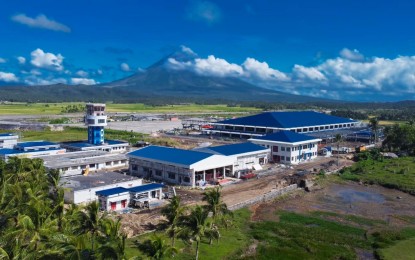
GATEWAY. The Bicol International Airport in Daraga, Albay, overlooking the world-famous Mayon Volcano, is among the big-ticket projects of the Duterte administration’s Build, Build, Build program. Its overall progress rate is at 79.74%, as of April 19, 2021. (Photo courtesy of DOTr)
MANILA – Long-dormant projects revived under the administration of President Rodrigo Duterte were the subject of the Department of Transportation’s (DOTr) pre-State of the Nation Address (SONA) forum on Monday.
Secretary Arthur Tugade gave updates on completed, ongoing, and planned transport projects, starting with the Ninoy Aquino International Airport (NAIA), now recognized as “one of the top 10 most improved airports” after its infamous “laglag-bala” (literally bullet-drop) extortion scheme before Duterte’s term.
The scheme saw passengers, including foreigners, being refused entry to or exit at airports after checkers allegedly find bullets concealed in pieces of luggage.
“We are also continuously pushing for the upgrade of the NAIA into a gateway that will stun the world. In fact, in February, in the midst of the pandemic, we inaugurated the rehabilitated NAIA runway, and its brand-new taxiways,” Tugade reported.
United Kingdom-based consultancy firm Skytrax named NAIA the 10th most improved airport in a 2018 survey, where 550 airports worldwide were monitored from August 2017 to February 2018.
More than 13 million survey questionnaires were completed by travelers worldwide.
Rome Fiumicino took the top spot in the survey that took into consideration ease of getting to and from the airport, terminal cleanliness, immigration process and staff, Wi-Fi service, and check-in facilities.
From 2016 to date, the Civil Aviation Authority of the Philippines completed 121 airport projects, including the Bohol-Panglao International Airport, Bicol International Airport, Mactan-Cebu International Airport, and the new Passenger Terminal Building of the Clark International Airport.
Backlogs addressed
In the road sector, the backlog of drivers’ license cards has been addressed, with licenses now with five-year validity and some with 10 years for those eligible under the Land Transportation Office’s (LTO) demerit system.
The backlog of vehicle license plates was addressed by the LTO through its Plate-Making Facility, with 3,188,843 pairs produced and distributed as of March this year.
To address the perennial congestion in Edsa, Tugade said the Edsa Busway reduced the travel time of commuters from Monumento to Pasay to at least 45 minutes from the previous nearly three-hour travel.
Bicycle lane networks were also established all over the country to promote active transportation and ensure the safety of cyclists, with 296-kilometers of bike lanes so far completed, including pavement markings, bollards, curbs, and solar studs.
“Our target is to complete 535 kilometers of bike lanes in Metro Manila, Cebu, and Davao before the year ends,” Tugade said.
Railway system
In the railway sector, he said the Metro Rail Transit Line 3’s (MRT-3) improvements, with trains now running at 60 kilometers per hour (kph) from the previous 30 kph, wait time between trains reduced to 3.5 minutes from the previous nine, and an all-time high of 23 trains running simultaneously from the previous 10 to 15 trains.
After being “stalled for decades”, Tugade also showcased the Metro Manila Subway which began construction in 2019; the Light Rail Transit Line 1 (LRT-1) Cavite Extension which began construction in May 2019; the Manila to Clark Railway scheduled to be completed by the fourth quarter of this year; the MRT-7 now halfway complete; and the Mindanao Railway Project, first conceived in the 1950s, now approved by the National Economic and Development Authority.
This year, he said, two “big-ticket projects” will be completed – the LRT-2 East Extension Project and the Common Station.
There will be an additional four kilometers to the 13.8-kilometer LRT-2 that currently runs from Recto Avenue in Manila to Santolan Station in Marikina.
The two new stations are Emerald Station, also in Marikina, and Masinag Station in Antipolo City.
The Common Station, meanwhile, is a 13,700-square meter concourse area that will connect the LRT-1, MRT-3, the 14-station MRT-7 (San Jose Del Monte, Bulacan to MRT 3 North Avenue, Quezon City), and the Metro Manila Subway.
“The investment poured in by this administration in the railways sector under the Build, Build, Build program is significantly larger than the total railway investments in the last 50 years combined,” Tugade said.
Maritime sector
The Philippine Ports Authority has likewise completed 426 seaport projects from 2016 to the present.
These include the Cagayan de Oro Port Passenger Terminal Building, the country’s biggest port terminal; and the repair and upgrade of the Ormoc and Tacloban Ports, Tagbilaran, and Maribojoc ports.
With the country’s Build, Build, Build program in full swing despite the limitations caused by the Covid-19 pandemic, Tugade said the DOTr and the rest of the government “will exert all efforts to finish what we have started, fulfill what we have promised, and deliver what we have envisioned.” (PNA)
